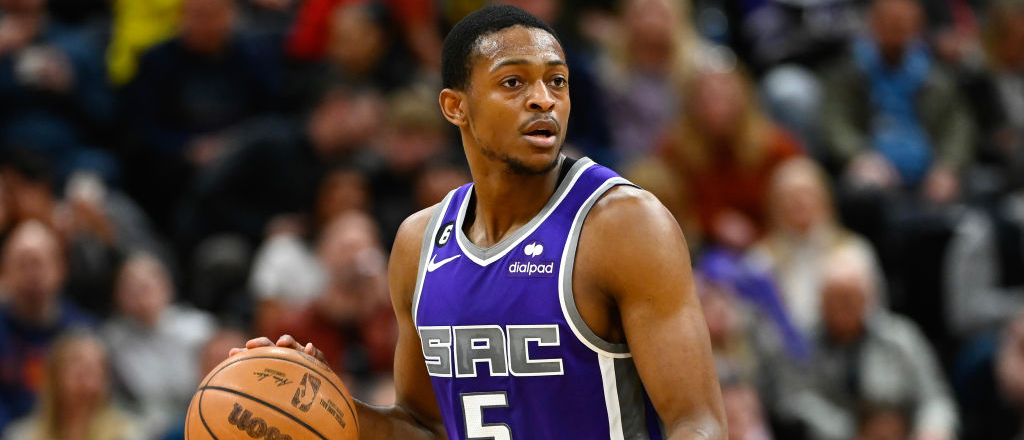When the NBA’s best point guards are discussed, it often feels like De’Aaron Fox is on the outside looking in. The shooting struggles early in Fox’s career made it seem unlikely that he would ever reach the upper echelon of lead guards despite his special speed and athleticism, a talented player who became another casualty of the perpetual Sacramento churn.
Two major moves started to change the narrative on the former Kentucky standout. First, the team drafted Tyrese Haliburton in 2020, and his shooting and playmaking paired with Fox’s relentlessness turned them into one of the league’s premier young backcourts. And then, a trade that will be argued until the end of time happened, as Haliburton was sent to Indiana for Domantas Sabonis.
Fox has been one of the biggest winners of the trade, which no doubt propelled him from a promising young guard into a full-fledged star last season. This year, he’s built on that success and is making his case for a seat at the table as one of the league’s biggest lead guards.
Last season, his first year under Mike Brown, Fox led the Kings to their first playoff appearance since the Bush administration while averaging 25 points per game, piloted the league’s most dynamic offense, won the NBA’s inaugural Clutch Player of the Year award, and became an All-Star for the first time. It’s safe to say Fox had a breakout year, one that was buoyed by his new partnership with Sabonis, whose screening and playmaking at the top of the key remapped the terrain for Fox on the court. Fox could get to his pet spots on the floor with much less resistance and always had Sabonis as a safety valve when he saw a wall at the rim.
While Fox and the Kings were a blast to watch in transition, their efficiency in the halfcourt was the primary driver behind their league-best offense. Last season, Sacramento was second in halfcourt efficiency according to Cleaning the Glass. In addition to the Fox-Sabonis pairing, Fox’s efficiency inside the arc made the Sacramento offense unstoppable. On jumpers between 3 and 10 feet, Fox shot a career-high 56 percent; he had never shot over 46 percent from that range in any season. That 3-10 foot range can be murky waters for an NBA player because it’s difficult to determine what kind of shot to shoot from there. Fox’s ability to get to that range at will and hit at a high clip also led to his high quality play in the clutch — that’s typically the area of the floor defenses will funnel a player towards and Fox routinely made defenses pay for that decision.
Fox has spent the early part of this year building on the foundation he built last season. He’s unfortunately missed a few games due to injuries, but in the 10 games he’s played this season, Sacramento is 7-3 while Fox is averaging a tick under 30 points per game. (They’re also on the verge of winning their In-Season Tournament group, and Fox has gone for 43 and 36 points in his two tournament games.)
Fox’s short jumper efficiency has extended beyond the arc this year. He’s shooting 37.2 percent on 8.6 threes per game, including a ridiculous 44 percent on pull-up threes, which ranks third in the league. If the pull-up efficiency is here to stay, it vaults Fox into a new tier of player. Going through his makes this season, Fox is consistently punishing players for going under screens or even just leaving him a little too much space. He’s not shooting like a player who is hitting threes at an above league average clip for the first time since 2019.
Fox’s shooting has forced teams to change their defensive coverages in ball screens. Going under is no longer an option against Fox and opponents are finding out that fighting through a Sabonis screen is…we’ll say difficult. The hard screens also force the opposing big to play much higher to prevent Fox from pulling a quick trigger three or getting to his spot in the mid-range. During one of his aforementioned monster In-Season Tournament games, Brown deployed a play that caused consistent problems for the Timberwolves, who have the league’s second-best defense. Setting a screen for Fox near halfcourt gave him ample space to either blow by the big or use their forward momentum to manipulate them. Minnesota was specifically vulnerable to this because they play so many two big lineups, but even defending these actions with a wing proved to be difficult.
Some of you may have though Mike Brown was joking here. He was not. The Kings ran the same play SEVENTEEN times in the 2nd half tonight.
Extended out horns set used as a high PnR for Fox. Screens coming near halfcourt makes it near impossible to stop an attacking Fox. https://t.co/CCZT0Lg6TV pic.twitter.com/Uz3vZwf7li
— Skyler (KFR) (@SacFilmRoom) November 25, 2023
A creative head coach and a brilliant pick-and-roll partner turned Fox into a nightmare, but he’s somehow become even scarier now that his jumper is becoming a more consistent threat. The list of solutions for him grows shorter by the day. And now, when the league’s best players are mentioned, Fox should start hearing his name.







